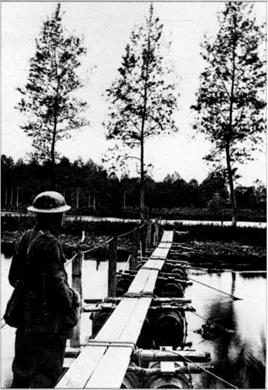Ground Fire — The Third Claim
The ground action against Manfred von Richthofens Fokker Triplane began with Lieutenant-Colonel Whitham’s soldiers tiring at it with their rifles as it passed over Vaux-sur-Somme. Captain Brown then made his rescue attempt. Further west, at a pontoon bridge over the Somme canal, where it passes behind a large farm house, Sergeant Gavin Derbyshire’s repair party also subjected the Fokker to rifle fire. Due to the bends in the river and the pre-occupation with work, the machine-gun crews hidden in the vegetation along the slope of the Morlancourt Ridge did not realise in time to respond that an enemy aeroplane was following the Camel which was approaching low down beside the river. It was not a common occurrence for German aircraft seldom chased Allied aircraft beyond the front lines.
The height at which Mays Camel and von Richthofens Fokker were flying may be judged from a statement by Lance Corporal Victor Ewart who was with the 56th Australian Battalion. Victor Ewart wrote in October 1937, from his home in Lakemba, NSW:
At the time I was attached to No.12 Section, No.11 Platoon. C. company, in reserves. Our position – or possies – were along a narrow road skirting a hill or plateau overlooking a valley running parallel with the road. Across this valley, known to us as Death Valley, was Villers Bretonneux. I wish to emphasise the fact that we were on the side of a hill overlooking a valley. The rest of our Battalion was scattered over the crest of the hill above and behind us. When the Baron chased the British ‘plane past our position he would be below the crest of the hill and therefore would be open to rifle fire which was concentrated on him from above and behind us. There were many men who had a shot at him and it is my contention that the Baron was brought down by an infantryman of the 56th Battalion AIF, whose identity will never be known. There were only two aeroplanes in the immediate vicinity, the chaser and chased. The Baron would only be about 70 feet from me and about 75 feet from the bottom of the valley when I shot at him with my rifle at an angle of about ten degrees. The men who were firing from above and at the rear of my position would be firing down on him; this would coincide with the medical evidence that he was fired on from above or from the air.
As described in detail in Chapter Two. the two aeroplanes were then confronted by the sharp left turn of the Ridge face where the Somme changed direction from west to south just before Corbie. Continuing straight ahead they made a steep climb followed by a half right turn to the north-west. Private Ray McDiarmid of the 8th Brigade, who later claimed to have been near the top of the Ridge, stated that he had seen the situation in time to open fire at the Triplane. He later ruefully said: ‘Unfortunately 1 did not lead far enough [aim in front of it| and my shots went behind.’
Authors’ note. Private McDiarmid tells a convincing story including that his helper with the Lewis gun obtained a souvenir from the red Triplane later that day; so it is certain that the correct event is being described. Unfortunately McDiarmid did not specify exactly where he was when he fired, and it has been assumed that he was on the wooded north slope at the time.
However, two aspects do not fit correctly. First; his unit, the 30th Battalion, 8th Brigade, 5th Division, was stationed south of the River Somme. Second; if he had been seconded to help out north of the river, his statement that after he had ceased firing, a machine gun to his left opened up raises some questions. McDiarmid’s firing position would have faced south, therefore the Triplane would have crossed his front from left (east) to right (west) on its way towards the 53rd Battery position.
All in all, it looks as though he was south of the canal but close to it. His helper would have had to cross the pontoon bridge behind the farmhouse and then ascend the slope. The time required to do that fits with the souvenir obtained; a piece of sheet metal front the Triplane’s petrol tank. Hardly one of the first items to be garnered.
Sergeant Gavin Darbyshire, 9th Engineers, down at the pontoon bridge, saw the first two aeroplanes climb the Ridge and heard several successive bursts of machine-gun fire. From his home in
Chinkapook, Australia, he wrote in October 1937:
Early that morning I was in charge of a party repairing pontoon bridges on the Somme, directly behind a farmhouse. Just after daylight a German ‘plane flew low along the canal and stirred us up a bit. Later, as we were busy at our work… we heard a machine gun burst and saw a plane coming our way. As I always considered a live engineer was much more useful than a dead hero I ordered all under cover. On looking out I saw the plane was one of ours flying very low. then behind it. and just above the trees. I saw a three-winged German plane firing madly at the one in front. We all hopped out and some of the chaps took pot shots with rifles at the Fokker. so close that we clearly saw the pilot. At this stage I am certain that the German was so interested on his job that he did not know where he was.
Now I consider this the acid test. The leading plane turned slightly towards a rather high ridge used by artillery OP. some of which I built; the German followed. At this stage we heard the roar of another plane going flat out at least half a mile further back from us. I then turned to look at the two leading planes just going over the ridge, heard a burst of gunfire and the Fokker stopped in its stride and did the first half of the loop then straightened out and fluttered down out of our sight as if doing a pancake landing. By this time the third plane was just approaching the ridge.
All this was vividly stamped on my mind and I was amazed later to hear that hen was brought down by a plane as the chaser was not firing at the time the German stopped.
These bursts of machine-gun fire Darbyshire heard would have been Private McDiarmid and those about to be described. The third aeroplane was no longer in sight; it must have slipped past overhead or behind him a little earlier with its engine throttled back whilst his men were firing their rifles at the Triplane and hoping that the Camel m front of it would clear the trees as it climbed. Several witnesses later commented on the motion of the Triplane in flight at this time. The interesting aspect is that they all used the word ‘unsteady’ which suggests that they may have read something about it during the interim.
Sergeant Cedric Popkin of the 24th Machine Gun Company, assisted by Private Rupert Weston and Private Marshall, had also opened fire with a
Vickers gun before the Triplane passed over the crest of the Ridge. Several different map references, two of them being prefixed ‘approximately’, have been given for the location of this gun. Three of them when plotted on an April 1918 map are down beside a road at the bottom of the Morlancourt Ridge and appear to be incorrect as Sergeant Popkin could not have fired downwards on the Triplane from any of them. The explanation for this mix-up is to be found in Chapter 17. The fourth reference, given by Popkin himself, is:’., in 62D. J. 19.d, about 600 yards from the crash site of the Triplane.’ This location would have permitted all the actions described by the Sergeant as having taken place that morning.
Sergeant Popkin’s Vickers gun was either mounted on a post or on one of the special, tall tripods which had been developed for anti-aircraft work. He later claimed that the ‘unsteadiness’ of the Triplane was the result of his shots having struck the aircraft. He added, with all honesty, that the Triplane ‘recovered’ shortly afterwards. This would be typical aircraft behaviour when flying in and out of a zone of severe turbulence such as would occur at that point of the Ridge on a windy day.
The noise of the aircraft engines and the ground fire alerted the troops for some distance around. Bombardier Secull picked up his rifle. This was the best he could do for, although he was in charge of the 53rd Battery’s two anti-aircraft Lewis guns. Gunners Buie and Evans were rostered for duty that morning as already stated. All three men had already been alerted by Sergeant Hart’s orderly to prepare for action. Buie was positioned at 62D. I.24.b.65.36 and Evans at 62D. I.24.b.73.43. The 53rd and 55th gun crews, who were hidden beneath camouflage netting, stopped work and watched.
Some witnesses said that the German pilot was firing heavily at the Camel. Buie later said:‘He was blazing away.’ Others said that the Fokker pilot several times leaned forwards in the cockpit and then fired a very short burst. Lieutenant-Colonel Fitzgerald said that each burst contained only two or three shots. One soldier. Private Smith, stated that whilst the German was passing over his head, he fired not a single shot. When the Triplane’s machine guns and ammunition belts were examined later, their condition indicated that only the last three observations were correct, and in that order. The suggestion has been made, and there is good reason to accept it, that it was at this point that von Richthofen’s right-hand gun stopped
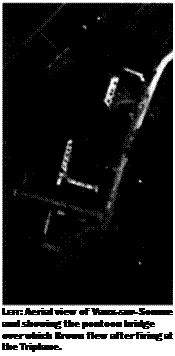
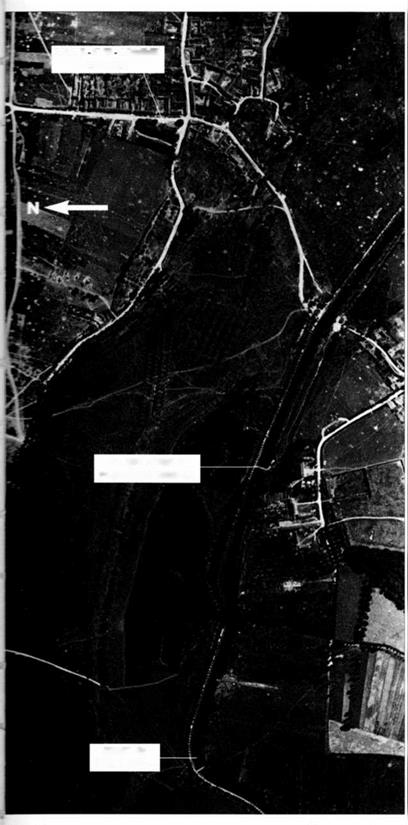 VAUX SUR SOMME
VAUX SUR SOMME
CHURCH
Above: Close-up of the pontoon bridge and the farm buildings.
![]() completely and that he decided to head for home.
completely and that he decided to head for home.
![]() Richthofen, who, one has to say, may not yet have noticed that ground fire was being directed at himself (although this seems unlikely, it is perfectly possible if everyone aimed like Private McDiarmid), had started a turn from north-west to north-east whilst May continued straight ahead to the north-west. When they first came into accurate range of the two Lewis guns manned by I3uie and Evans, Mays Camel had been interposed between them and the chasing Triplane. Gunner Buie later acknowledged that the first to get a clear shot was Evans. As the low flying Triplane proceeded in its turn Buie also got a clear view and opened fire. Buie was very specific that the Triplane was flying towards him
Richthofen, who, one has to say, may not yet have noticed that ground fire was being directed at himself (although this seems unlikely, it is perfectly possible if everyone aimed like Private McDiarmid), had started a turn from north-west to north-east whilst May continued straight ahead to the north-west. When they first came into accurate range of the two Lewis guns manned by I3uie and Evans, Mays Camel had been interposed between them and the chasing Triplane. Gunner Buie later acknowledged that the first to get a clear shot was Evans. As the low flying Triplane proceeded in its turn Buie also got a clear view and opened fire. Buie was very specific that the Triplane was flying towards him
|
|
|
|
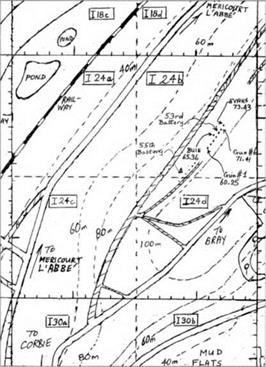
a little to his right. Evans’s evaluation of his own situation is not on record.
Although the Triplane was an easy target, it was by no means so easy to hit. Being low down and close to Buie and Evans, the Triplane was changing position rapidly relative to them and they had to swing their Lewis guns quickly both horizontally and vertically in order to follow it. An added complication, which might not have occurred to them (they were not trained, expert anti-aircraft gunners) was that the Triplane was not moving in the direction it was headed. The Triplane was headed approximately north at 110 mph (165 feet per second, approx) and the air by which it was supported was moving west at 25 to 30 mph (3K to 45 feet per second). The gunner, who merely allowed for the speed of the Triplane, would, by the time he had pulled the trigger, find that the pilot’s body had moved about seven to nine feet to the west and his shots would therefore strike somewhere (like the same seven to nine feet) out on the right wings.
Using short bursts, Buie fired a whole pannier (drum) of 47 rounds at the Triplane. Assuming that he and Evans did allow for the strong east wind (blowing the Triplane to the west) the first shots of either gunner would have struck the pilot almost
frontally in an upwards direction unless he had been twisted around in the cockpit at the time, checking his rear. Buie’s final burst would have been about 45° upwards relative to the ground but. due to the Triplane’s angle of bank, would have struck the pilot somewhere between horizontally and slightly upwards relative to his seated position in the cockpit. It is important to bear in mind that a Lewis gun has a much tighter pattern than a Vickers gun, and at close range it is normal to find three or four bullets in any target that has been struck squarely, ie: not hit near the edge.
That the two gunners did not allow for the sideways motion of the Triplane is suggested by Gunner Buie and others nearby claiming to have seen ‘splinters’ flying from the Triplane’s tail. This is another case of the deceptiveness of a slant view. Unlike most British aircraft, the Triplane’s fuselage and tail were made from welded steel tubes covered with fabric. There was some plywood used for the fairing around and behind the cockpit but. during the later examination, no bullet holes were found in it. Indeed, looking at photographs of the tail when the machine was at Poulainville, there are no signs of any bullet holes at all.
The Triplane’s wings were made from wood and fabric. The wide interplane struts were also made
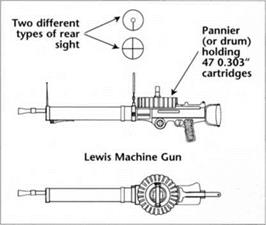 |
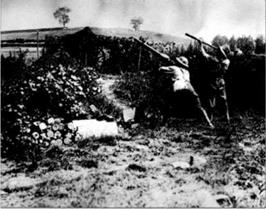 |
Above: Lewis machine gunner, with gun on
tripod, supported by his spotter with telescope.
Note camouflaged 18-pounder gun.
Above right: Lewis gun.
from wood. Splinters torn from any of these would have slowed down enough to become visible as they flew by the tail. Von Richthofen made an immediate turn to the right. With a pilot of his skill and combat experience this would have been a flat turn. A little known trick outside the flying fraternity was to skid sideways by applying rudder and opposite aileron. In the Barons situation, his best move was to apply right rudder and left aileron; this would double his rate of sideways travel relative to the direction in which the nose of his Triplane was pointed. To climb would have been fatal in that the Triplane would then be following a predictable flight path. His tactic was obviously fruitful for a while but a few hundred yards away, a trained and highly successful anti-aircraft machine gunner who knew that trick, and could make rapid mental judgement of by how much to lead the target and how much to allow for the wind, was watching and biding his time. His name was Vincent Emery, his helper was Jack Jeffrey.
A few seconds after the right turn of the Triplane, Gunner Buie saw it begin to act strangely. In later years, Buie told his nephew, Morris, that he did not replace the drum and fire again because there was no point in it; the Triplane was obviously finished. Private Frank Wormald, who was standing beside Buie, later claimed to have seen Buies tracer:’…going like a red streak towards the cockpit and striking the pilot’s chest! He added that the pilot made a motion rather like shrugging his shoulders and then sat up erect in his seat. Without doubt Wormald saw Buies tracer heading towards the Triplane but to affirm where it hit would have been a conclusion based upon later information
that there was a large hole in the Barons chest. There is simply no way a man on the ground would be able to see much more than the top of the pilots head (flying helmet) in a Triplane coming straight at him, sitting behind a large engine, twin machine guns and a windshield and cockpit fairing!
In their short machine-gun trench at Sainte Colette beside the Corbie to Bray road, Privates Emery and Jeffrey saw the two aircraft separate as the Triplane turned away from the Camel and headed in their direction (from north to northeast). These two soldiers were part of four Lewis – gun crews on assignment from the 40th Battalion, to defend the supply routes to the front from surprise German air attacks. Emery was an expert anti-aircraft gunner with four German aircraft already shot down to his name, and like the professional he was, he swivelled the Lewis gun, aligned it on the target and accustomed his eyes to the light and the distance. Private Jeffrey placed a spare pannier ready for use.
With the Triplane now flying almost directly towards them, heading east along the Ancre (northwestern) side of the Ridge, at low altitude, it appeared that Private Emery was about to become an ‘ace’. Ironically, von Richthofen may have just spotted the Australian 18-pounder guns on that reverse slope. Gunner R L C Hunt, who was part of the crew of No.6 gun, the one furthest north, claims that the red Triplane passed overhead, between guns No.5 and No.6. This would place Buie and Evans obliquely below it, Evans being on its left and Buie on its right. Buie was behind gun number four and Evans beyond gun number six out on the far left (north-east) side. The camouflage netting over the guns would not be very effective against observation from as low down as that. To enable the exact location of the two batteries to be

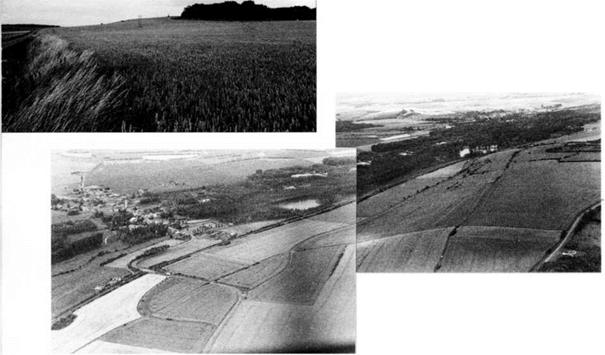 determined had been one of the main reasons JGI group had been called into the area, to help, by clearing the sky. German two-seaters to spot them. If he had seen them, it may have gone through his mind in those last moments that this information was something urgently needed.
determined had been one of the main reasons JGI group had been called into the area, to help, by clearing the sky. German two-seaters to spot them. If he had seen them, it may have gone through his mind in those last moments that this information was something urgently needed.
The two gunners waited for the triplane to come closer. It was shortly to do so in a most unexpected manner. They heard Vickers gunfire, Lewis gunfire and a lot of rifle shots from the fields to their west. The noise would have been a little delayed in reaching them due to the distance and the strong east wind. It would appear to have been at this time that von Richthofen realised exactly where he was, especially if he had seen those lb – pounders a moment earlier. He was approaching a very tall chimney made to look like a tin whistle by shell holes blown in it. and joined to a building
Below: The site of the 53rd Battery taken in July 1996, facing north. The Morlancourt Ridge is off to the right while the road runs from Corbie to Mericourt-l’Abbe.
which stood almost alone in a field. Until now it had been below the skyline and had blended in with the dark background. It could only be Sainte Colette brickworks. There was no other tall chimney isolated like that for miles around.
The machine-gun firing had ceased, and apart from the odd rifle shots, which Lieutenant Wood later claimed came from his platoon, things had become quiet. The Triplane began another right turn and started to climb. If it continued along that path, it would shortly be right side on to Sergeant Popkin’s Vickers gun. The Sergeant prepared to open fire for the second time.
Private Scott, a signaller who watched the action, stated that:‘Hundreds of soldiers were firing rifles at the Triplane.’ Private Ernest Boore. Private Henzell and Trooper Howell, later claimed success (see Appendix K).
Privates Emery and Jeffrey, and Lieutenant George M Travers, later described how the climb had suddenly steepened sharply and the Triplane almost turned over to the right. They heard the engine roar. Many others, who also saw the event, interpreted it as a steeply banked climbing attempt to escape. The wind and the distance made von Richthofen’s initial increase to full climbing power seem to belong to the violent pull-up and twist. Not being fighter pilots, the viewers did not realise what they had just seen. It was the instant when von Richthofen’s body reacted to a spasm following a sharp stab of pain, caused by a severe wound on a right-handed person. The uncontrollable muscular contraction caused his grip to tighten on the stick and his arm to jerk it back and to the right.
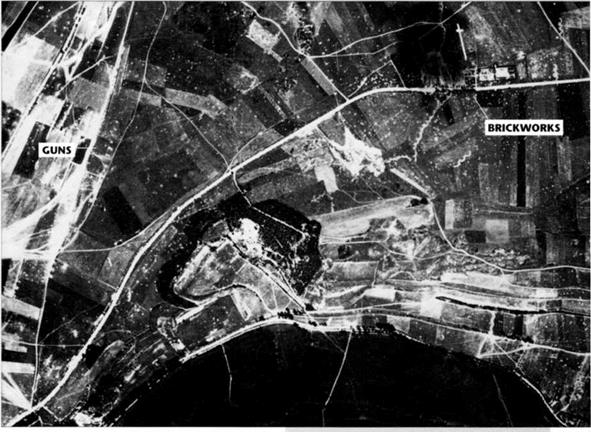 |
This reaction was well-known to the ace fighter pilots on both sides. The Baron s brother, Lothar, and A Ci Lee (in his book. Ye Parachute) both describe how they attacked an enemy aeroplane and whilst firing at it saw it nose up steeply. This, they both wrote, was a sure sign that the pilot had been hit.
Authors’ Note: Dr.-Ing Niedermeyer pointed out the muscular contraction phenomenon, and it was confirmed by Doctor Jose Segura Ml) when his opinion was requested. The reader has only to imagine a sharp dig in the ribs to understand the reaction.
Private Emery stated that he saw the pilot stiffen and then appear to collapse in his seat. Gunner Ridgway said that the pilots head fell over to the left. As Emery did not hear any machine guns firing at this time, he assumed that one of the rifle shots had struck the pilot. He then heard the distant noise of a Vickers gun. However, it must be borne in mind that, due to the wind and the distance, sound was not synchronised to sight; it was, in fact considerably delayed in Emery’s direction.
Aerial picture showing the actual gun position of the 53rd (right) and 55th (left) Batteries in the upper left quarter.
Major Blair Wark VC. the second-in-command of the 32nd Battalion, who watched the sudden climb, made a statement in 1933 which agreed basically with Private Emery, in that he said:
The fatal shot came from another machine gun than those with the 53rd Battery and the 24th MG Company [Popkin], but definitely from one firing from the ground. A number were firing at the plane.
Gavin Darbyshire, watching from below by the canal, seeing the events from one side, saw the loss of forward motion resulting from the pull-up and twist of the Triplane. He described the pull-up as that performed at the beginning of a loop; the Triplane then nosed down and disappeared below his line of vision. Darbyshire added:
[The Baron] was either hit from the ground or his machine was put out of control from the ground, as when the burst came his forward flight stopped as if he had run up against a brick wall.
Written in 1937, Darbyshire’s words are completely original and could not have been swayed by anything he might have read, as later ‘witnesses’ may have been. Many of the latter have mentioned the word ‘stagger’ or the ‘plane staggered’; the repetition of this word staggered suggests a common source. Staggered does not make aeronautical sense either.
The Triplane was seen to cease its apparent attempt to escape and to ‘wallow around’ in the sky. The Triplane turned half left, which would have been into the wind, and as a result of the delayed sound, an apparent reversal of a logical sequence was noted by witnesses in that the propeller was seen to slow down and the engine note was heard to change; in that order. In retrospect it can be seen that von Richthofen began preparations for a forced landing in the nearest open space; the field at Sainte Colette where Captain Turner and Lieutenant Wood had their respective FOPs.
Based upon the testimony of witnesses who observed the beginning of the descent of the Triplane and of others who examined it afterwards, it appears that the following then happened.
Upon recovering control of his machine and realising that the wound which he had just suffered was serious, von Richthofen immediately initiated standard, emergency procedure. He needed to get down quickly before he passed out, and to get medical help, even from the British. He turned into wind, looked for and found a suitable field nearby and decided to land there. He automatically took steps against fire following a possible mishap in a rough field by closing the fuel valve, (the equivalent of the throttle on an Oberursel or Le Rhone rotary engine) opening the vent valve of the pressurised petrol tank, and switching off the magneto. To use the cool air as an aid to maintain his fading faculties he pulled off his flying goggles. They fell overboard and were picked up by Private E E Hardaker of the 11 th Brigade, who kept them for many years; they were later acquired by Pat Carisella. The watchers from the 53rd Battery saw the Fokker, which was obviously on its way to earth, disappear behind the trees to their east. Behind those trees lay the field with the FOP across the road from the brickworks with the tall chimney. Thereafter began the rush of soldiers to the field at Sainte Colette.
Both the 53rd Battery gunners Buie and Evans, and the 24th MG Company’s Sergeant Popkin, entered claims for downing the red Triplane. It is worth noting that Gunner Buie truly believed he had put several bullets frontally into von Richthofen. In civilian life he lived by fishing and by hunting wild fowl. He was known locally as a ‘crack shot’. In December 1959, the magazine Cavalier published an article entitled: I Killed Richthofen which contains the following assertions by Robert Buie:
Richthofen was struck in the left breast, abdomen and right knee. The wounds were all frontal. Two separate medical… reports agreed that the fatal chest wound was definitely frontal.
Gunner Evans also believed that he had put some bullets into von Richthofen. In a letter to his mother, Evans asked her to tell his Uncle Bill that he could still shoot straight. It has to be assumed too, that soldiers returning from the crash site, having seen the blood down the front of Richthofen’s body and on his knees, tended to confirm frontal hits. With both Buie and Evans adamant that they had hit the pilot frontally, they had nowhere else to go with their stories.
In Sergeant Popkin’s report, dated 24 April 1918, he stated after seeing the body he believed that at least three machine-gun bullets had struck the body, one in the ribs at the side and a couple through his chest. Later, according to a telegram sent by him dated 16 October 1935, to С E W Bean, the Australian historian, he explained that the first time he opened fire on the Triplane it was travelling directly towards him [coming from the direction ofVaux| and at a lower level than his gun position; the second time it was passing by a little way off and higher up (atop of the Ridge| with the right-hand side of the machine towards him. In the first case he would have been aiming downwards and in the second case, upwards.
Unfortunately for Popkin, the paperwork for his claim was not made out immediately. With a type of black humour it can be said that this was fortunate for General Sir Henry Rawlinson otherwise his dilemma that evening would have been four official claims, not three.











